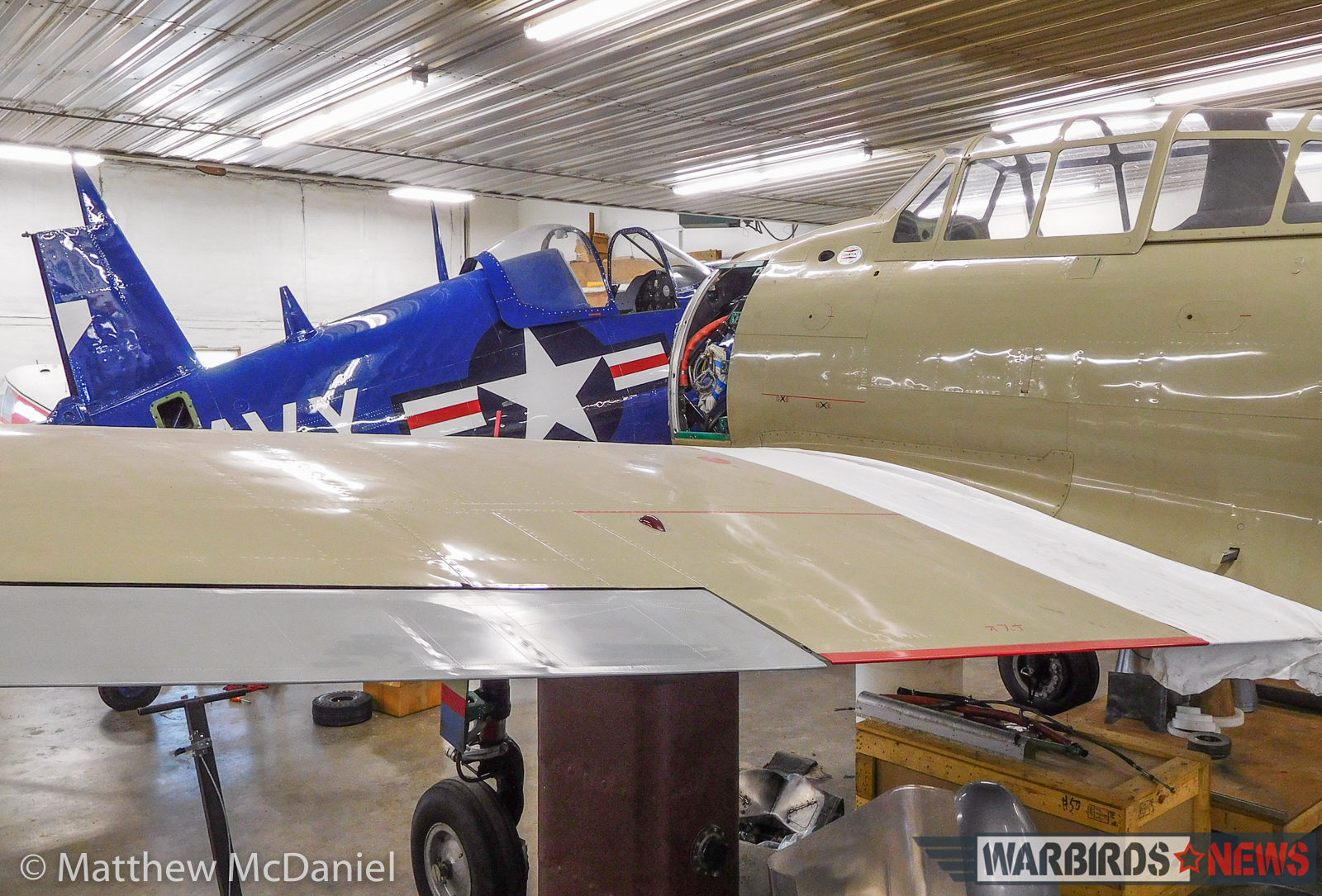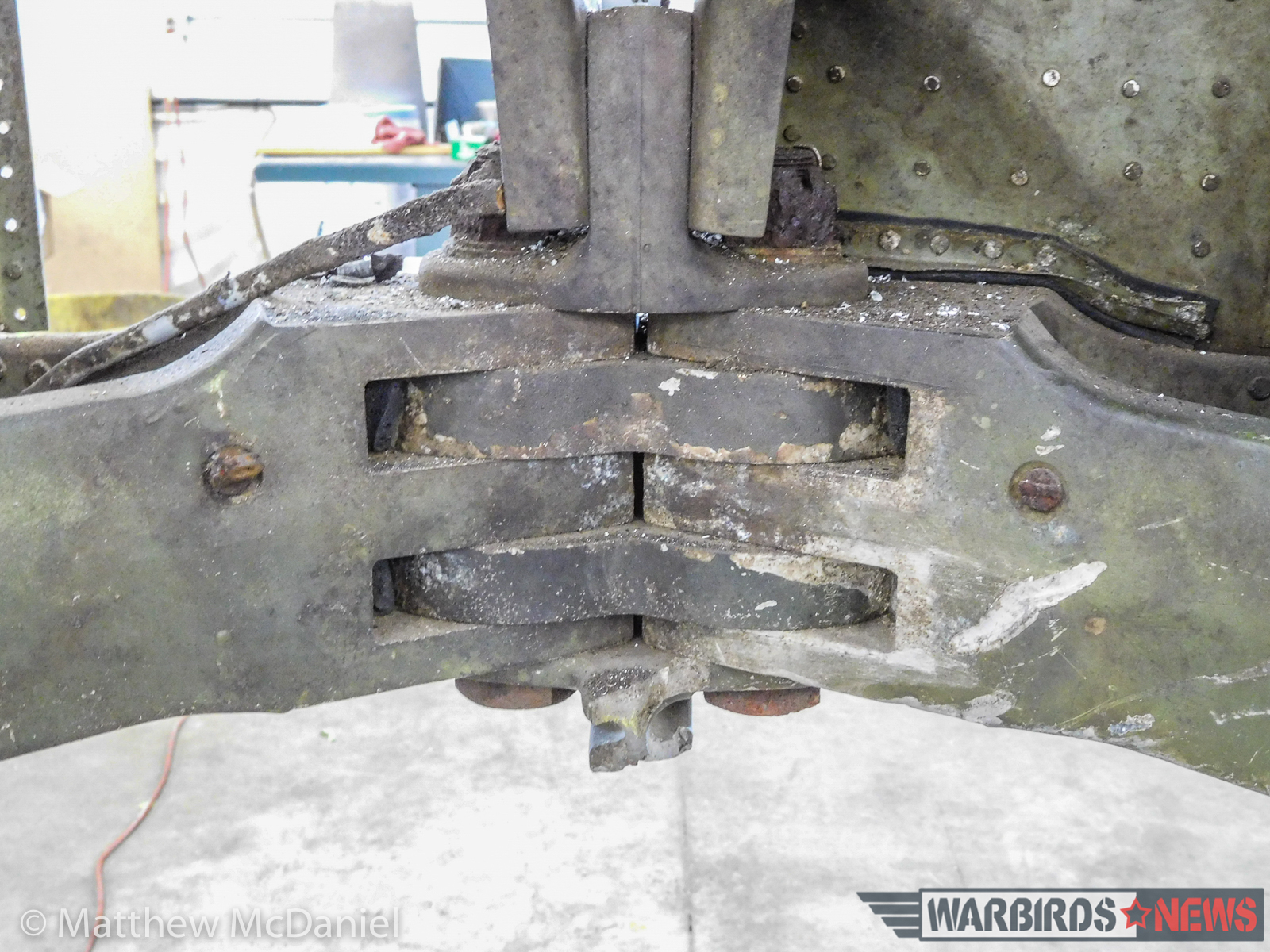
Warbird Project Update: Gerry Beck’s Shop Carries on His Legacy
by Matthew McDaniel
Most WarbirdsNews readers should recall the name ‘Gerry Beck’ as the master builder/restorer of so many vintage warbirds. Starting with custom parts fabrication for TBM Avengers and P-51 Mustangs, Beck eventually worked his way up to rebuilding entire aircraft. In short order, his shop began to specialize in P-51 restorations and often had a half-dozen or more of them underway simultaneously. When Gerry decided that an A-model Mustang was the object of his desire, he quickly learned that there were no worthy candidates available for restoration. So he decided to build one from scratch – a full-scale, Allison powered, “homebuilt,” replica P-51A Mustang! That’s exactly what he did too, much to the astonishment of the warbird establishment. When the ‘A’ showed up at Oshkosh in 2006, predominately displayed in AeroShell Square, the throngs of gawkers crowding around the aircraft could be seen going slack-jawed upon learning the polished aluminum and lime green gem was not a rebuild, nor a restoration, but was hand-built from fresh metal at a tiny aircraft shop in Wahpeton, just inside the North Dakota border with Minnesota. That shop was Gerry Beck’s Tri-State Aviation.
Known to most of his friends and family simply as “Beck,” Gerry preferred to refer to his P-51A as a “recreation.” In fact, he even assigned it Serial #311 because the original production of P-51 A-models ended at #310. For it’s short stint on the air show circuit, the Mustang bore the markings for the famous Reno racer Precious Metal II, as it portrayed that aircraft in the film, “Thunder over Reno.”
In a tragic loss for his family, friends, and the entire warbird community, Gerry died at Oshkosh in 2007 when his P-51A collided with another Mustang just over the runway during landing recoveries following an air race demonstration. No one would have blamed Cindy, his wife and business partner, if she’d closed their shop, sold the aircraft and parts inventory, and turned her full attentions to family matters and their custom wood-turning business. But Cindy was determined to see Beck’s hard work go unwasted, his visions carried out, and his legacy honored. The obvious way to fulfill those dreams was to carry on his life’s passion – returning warbirds to the skies to honor the veterans who flew them and allow future generations to marvel at their graceful, yet menacing, beauty. Nearly a decade later, this is exactly what Tri-State Aviation is doing and they currently have several unique projects in the works.
———————————-
Corsair Emerging From Hibernation
One of Beck’s first big-ticket warbirds was former US Navy F4U-4 Corsair Bu.97388. Meticulously restored over a 16 year period, it returned to airworthy condition in 1998. During the off-season, the Corsair was on display at the Fargo Air Museum from the time that facility first opened. After completing the P-51A, Beck had less time to devote to the Corsair, and it became a year-round resident at the museum. While it remained a valued part of the collection, Cindy recently decided to return the Corsair to airworthy condition and had it ferried from Fargo to Wahepton for inspection and refurbishment. When completed, the aircraft will return to the air show circuit and spend the off-season at the Wings of the North museum in Eden Prairie, Minnesota. Like most warbird projects of this magnitude, no definitive timeline exists for completion, but the Corsair will likely fly again in 2016 and hopefully participate in at least part of this year’s air show season.
During WarbirdsNews’ visit to Tri-State Aviation in early June, 2016, the bent-wing fighter was still being refurbished with particular emphasis on replacing its fabric coverings (all primary flight control surfaces and the underside of each outboard wind section). Engine work was also underway. When completed, 97388 will emerge with a fresh annual, new fabric, and be as pristine as she was when Beck completed her 18 years ago. It will be great to have yet another fine Corsair not only airworthy, but being actively flown and giving air show audiences an opportunity to hear “Whistling Death” in person.
Zero Recovering From Tail-ectomy
The oldest Mitsubishi Zero to fly in the warbird era currently sits in the Tri-State shop, tailless and looking a bit forlorn following a runway incident earlier this year. But rest assured, this is a temporary condition, as work progresses in two countries to bring the A6M2 Type 0 Model 21 back to airworthy status.
The South Pacific island of Ballale was a base for both Imperial Japanese Navy and Army Air Force operations during WWII. It was also Admiral Yamamoto’s destination during that fatal flight when American P-38 Lightnings intercepted and shot down his plane on April 18th, 1943, dealing a major blown to the Japanese war effort. It was within the dense jungle on Ballale that noted warbird salvager, Bob Diemert, rediscovered this Zero in the late 1960s. Production information on the airframe indicated the Mitsubishi design was one of 880 Model 21 variants built under contract by Nakajima. Restoration of the famously nimble fighter was completed in 2004, after an estimated 60,000 hours of work by both the Blayd Corporation in Canada and Tri-State Aviation. One can argue whether to call this aircraft a restoration, a replica, a recreation, or a reproduction. While it does contain some original parts within the landing gear system, it was mostly built by templating and reproducing the parts from the original wreck. Having any original parts included in an airframe generally earns it the label of “restoration.” However, this Zero is also powered by a Pratt & Whitney R-1830, rather than the original and ultra-rare Sakae engine. While the R-1830 is of similar size and horsepower to the Sakae, it is far more practical to maintain and required only small cosmetic concessions for its installation on the Zero. As such though, this Zero is often referred to as a replica, reproduction, or recreation, built to the A6M2 Model 21 specifications that represents the salvaged (but unrestorable) parts. Semantics aside, this is an exceedingly rare machine with both the appearance and performance of its lineage. An aircraft with such a rich history is well deserving of the attention it’s currently receiving in North Dakota.
Operated by the Texas Flying Legends, the aircraft was displayed both statically and in flight until earlier this year. In March 2016, while enroute to a Los Angeles airshow, the Zero and several fellow Flying Legend aircraft stopped in Midland, TX to refuel. While taxiing, the diminutive A6M2 disappeared from view under the long nose of the Goodyear FG-1D Corsair behind it. Overrunning the Zero, the Corsair’s massive prop literally shredded the Zero’s empennage, destroying all tail surfaces, the aft portion of the fuselage, and damaging the wingtips as the little Nakajima was tossed about. Fortunately, no one was hurt.
Fellow native North Dakotan, Warren Pietsch, owner of the Zero, immediately began planning repairs. They removed the empennage and shipped the remainder of the aircraft to Cindy Beck’s team. There the wing damage is being repaired and the aircraft is being inspected, refreshed, and updated as necessary. A new empennage is being build in Canada by the Blayd team that did most of the templating and manufacturing involved in the original reproduction process. The Texas Flying Legends Museum reports that they expect the Zero (and their FG-1D Corsair) to be back in the air this year.
A Beastly Wing Takes Shape
Often referred to as “The Beast” (among other colorful nicknames), the Curtiss SB2C Helldiver fit that description on many levels. The Helldiver was built to absorb punishment and in proportions that seem to defy it’s use on carriers. When one sees the massive wing structure hanging in the back of the Tri-State shop, it’s sheer size and beefiness seem more tank-like than aircraft. Then, you realize you’re only looking at the wing’s center section and that the two outboard wing sections aren’t even attached! For decades, there has only been a single airworthy Beast – the CAF’s SB2C-5 Bu.83589. This should change in the not-so-distant future.
In July of 1945, SB2C-5 Bu. #83393 stalled and crashed into woodland during a forced landing attempt at NAS Dahlgren in Virginia, sadly killing the pilot. Former naval aviator, Kevin Smith recovered the wreck on behalf of the National Air & Space Museum in 1994, and eventually acquired ownership of most of the parts, representing about 85% of the aircraft. Smith sold the project to Fagen Fighters in Granite Falls, Minnesota during 2006. Fagen Fighters has been working on the Helldiver ever since and has made significant progress, with the basic fuselage structure and empennage now being complete. To speed things along, Fagen Fighters farmed out the wing rebuild to Tri-State Aviation. The wing’s condition is rough to say the least, having suffered significant structural trauma in the 1945 crash landing. While much of the wing’s center section is restorable, Tri-State will have to refabricate many components, including nearly all of the outboard wing section structure.
Precise molds are being made for the manufacture of scores of wing ribs. Jigs are already set up for the reconstruction of the outboard wing sections. While the SB2C restoration is a massive undertaking, the talented teams at Fagen Fighters and Tri-State Aviation have the knowledge and skill to see the task though to completion. When that time comes, the population of airworthy Helldiver’s will double and this particular “Son of a Bitch, Second Class” will undoubtedly be in First Class condition.
Conclusion
While these three projects are currently taking center stage at Tri-State Aviation, many more are waiting in the wings. Not the least of which is Beck’s P-51A which has already been extensively repaired. If all goes as hoped his scratch-built Mustang will return to the skies in the future and streak past the pylons as a Reno racer too. The Tri-State storage hangar is a treasure trove of warbird pieces and parts. Well organized shelves house enough P-51A parts to build another entire example, maybe two. But, regardless of what the future holds for Cindy Beck’s little warbird shop in North Dakota, at present it is still doing exactly what her late husband would have wanted – turning out incredible work on some of the most iconic aircraft of the WWII era. Somewhere, Beck is smiling about it all, I’m sure.
——————————————-
About The Author: Matthew McDaniel is a Master & Gold Seal CFII, ATP, MEI, AGI, & IGI and Platinum CSIP. In 26 years of flying, he has logged 16,000 hours total and over 5,500 hours of instruction-given. Currently, he flies the Airbus A-320 series for an international airline, holds eight turbine aircraft type ratings, and has flown over 80 aircraft types. Matt is one of 25 instructors in the world to have earned the Master CFI designation for 7 consecutive two-year terms. He’s been a freelance aviation author since 2003 and owns Progressive Aviation Services, LLC (www.progaviation.com). He can be reached at: [email protected] or 414-339-4990.
Copyright 2016, Matthew McDaniel. First publication rights granted WarbirdsNews. All other rights reserved by copyright holder.
































